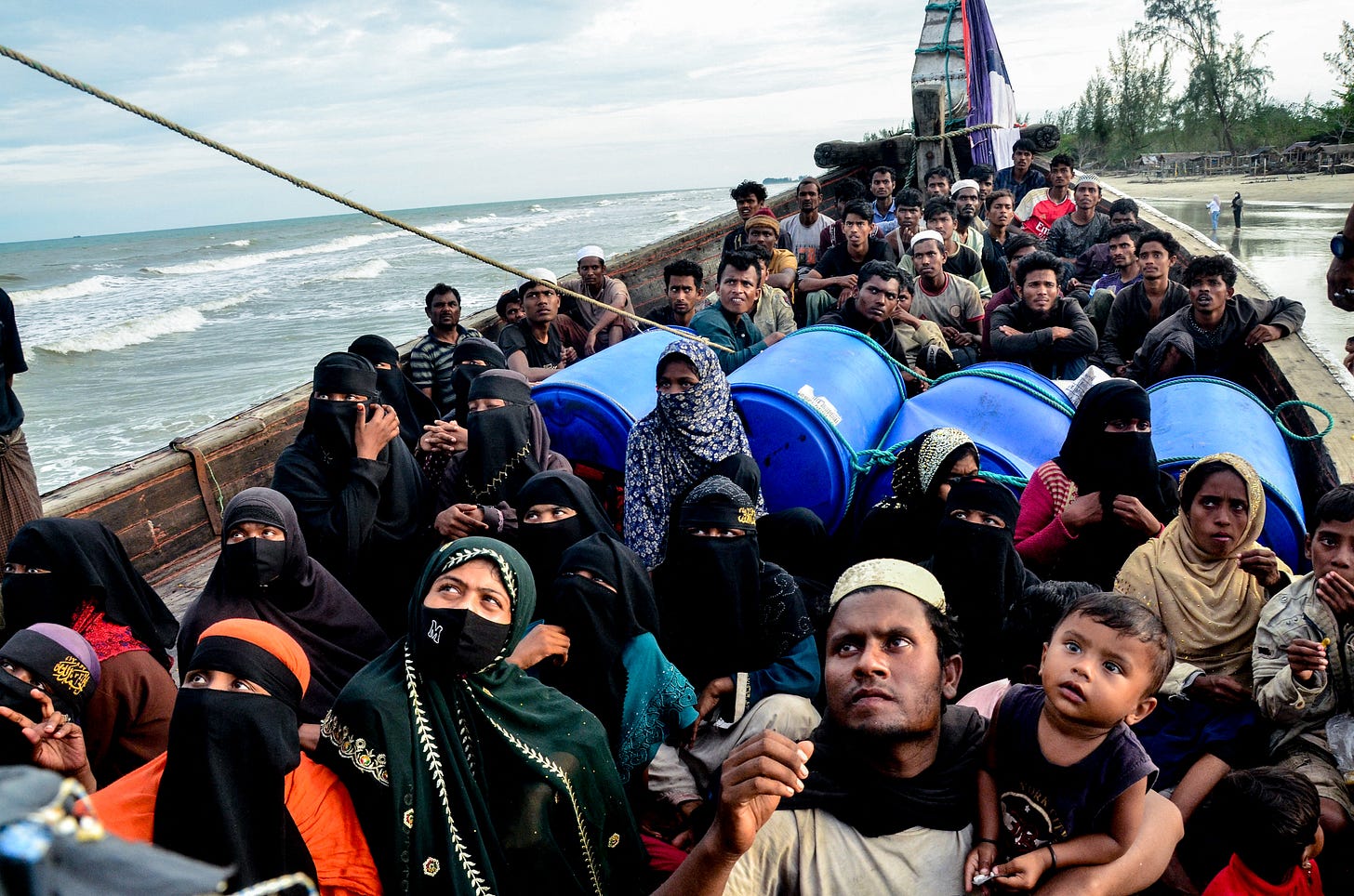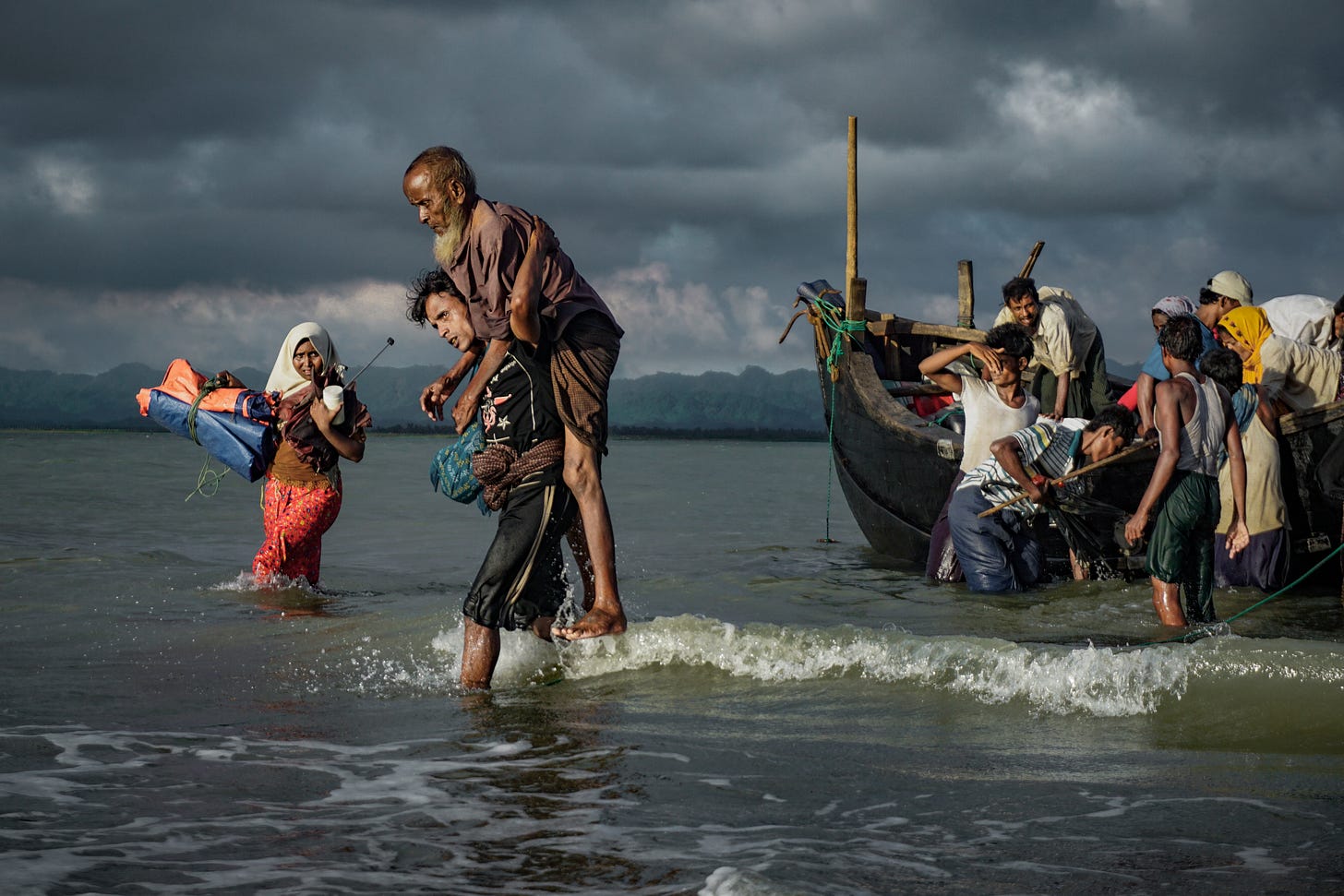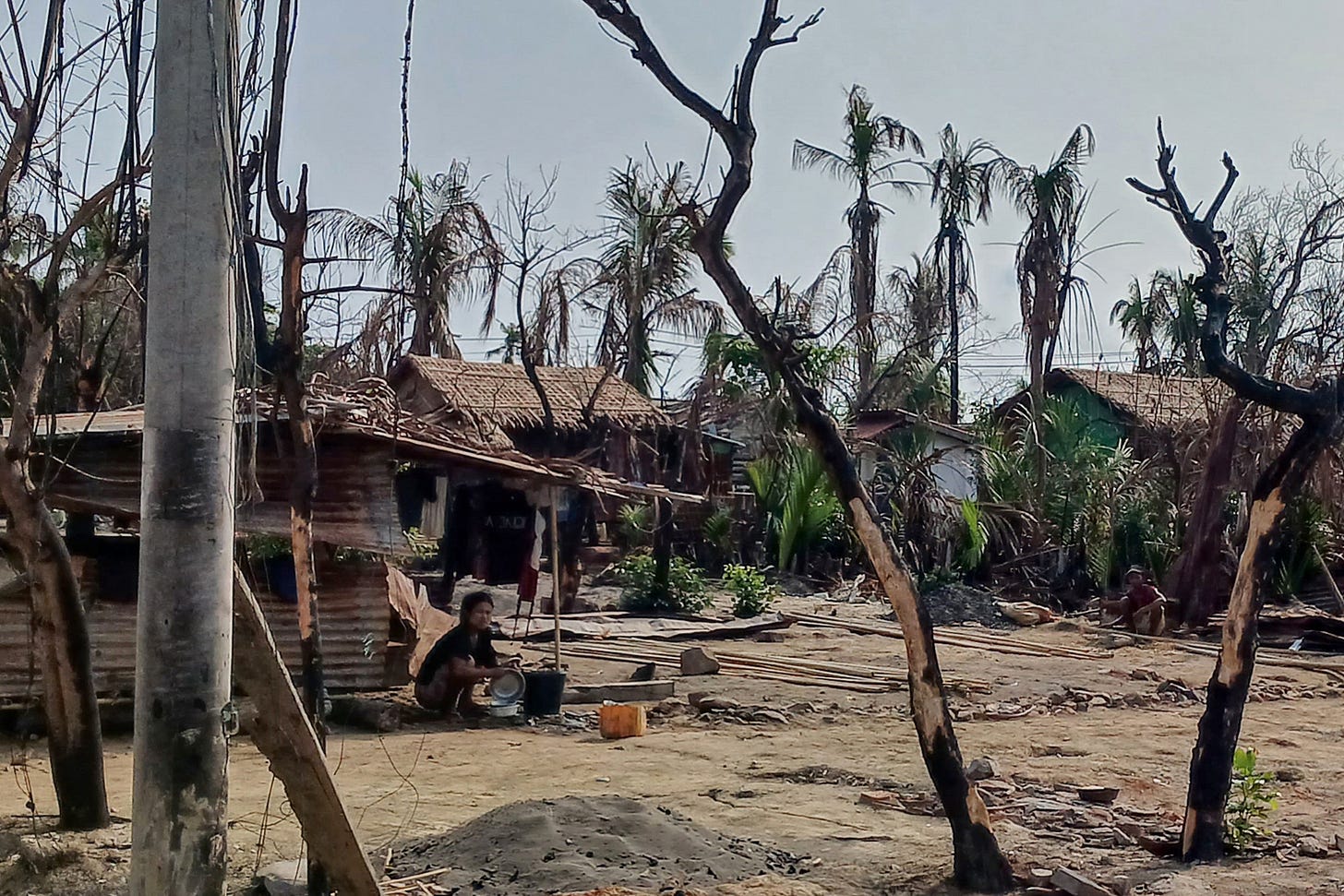The Rohingya, Gaza, and Two Genocides the World Refuses to End
As I watch Gaza, I can't help but think about what's been inflicted on the Rohingya in Myanmar and the role Israel has played in it, writes Burmese activist Maung Zarni.

Eight years ago, the Myanmar armed forces launched a textbook genocide, physically destroying the Rohingya people in their own ancestral region in Rakhine state. Myanmar’s army set entire Rohingya villages ablaze. Thousands were killed. Women, girls, and the elderly were raped.
It was perhaps the first images of ethnic cleansing to this scale – masses of people being forced to leave their lands – televised on our screens. The violence continues today, even as we watch yet another genocide unfold before our eyes. As I watch what is happening in Gaza, I cannot help but think about a similarly genocidal violence perpetrated on the largely defenseless civilian population of Rohingya in my native Myanmar and the role Israel has played in it.
There are, of course, a lot of differences between what is happening to the Rohingya and the unconcealed war of annihilation being inflicted on the Palestinians in Gaza. For one, Israel’s genocide in Gaza is being supported and funded by the United States. Importantly, as well, the Holocaust memorial museums led by the one in Washington have acknowledged Myanmar’s persecution of the Rohingya as genocide. In sharp contrast, these same institutions have failed in their responsibility to apply their “Never Again” slogan to Gaza’s Palestinians. But both genocides are being carried out by two apartheid states – both established in 1948, who have largely enjoyed good relations (Israel itself has sold tens of millions of dollars in weapons to Myanmar’s military) – against the predominantly Muslim peoples they’ve persecuted for decades, all while the world watches on.
As we mark Rohingya Genocide Remembrance Day, it’s important to reflect on the ongoing genocide of the Rohingya, what we haven’t learned from the eight years of violence, displacement, dispossession, and, painfully, the impotence of international law in the face of sheer military might and attempted land grab in two very different parts of the world.
Who Are the Rohingya?
Several decades before the headline-making mass exodus of Rohingya in August 2017, Myanmar subjected this predominantly Muslim population to a slow process of group destruction, using both law and orchestrated campaigns of violence.
Since the military coup in 1962, Myanmar’s generals have built a multi-tiered citizenship system anchored in the notion of racial purity, enshrined in the 1982 Citizenship Act. Myanmar bears all the hallmarks of an apartheid state, with Buddhist Burmese at the top, and Rohingya and other Muslims at the bottom. After 1982, Rohingya were no longer able to obtain citizenship; instead, they were given foreign identification cards, which became integral to the genocide itself. As a matter of policy, Myanmar limited their educational opportunities and the type of work they could do, and made them a stateless people on their own ancestral land.
Periodic incidents of large-scale exodus of the Rohingya began as early as 1978, as the military violently forced out large numbers of Rohingya across the border into the newly independent Bangladesh, a Muslim-majority country.
In 2011, Myanmar transitioned to a military-dominated civilian government and set off on what, at the time, was considered the country’s reformist era – a period that was lauded by Western governments, including the US, with then-President Barack Obama and his Secretary of State Hillary Clinton praising as example of reforming authoritarians which “the rogue states” of North Korea and Iran should emulate.
Things, however, did not improve for the Rohingya.
In a study looking at the treatment of the group from 2011 to 2014, my colleague, Natalie Brinham (who at the time published under her penname Alice Cowley), and I found that since 1978, Rohingya had been denied and deprived of livelihoods opportunities, freedom of movement both inside their ancestral region of Rakhine and throughout other parts of the country, access to education, healthcare, and protection of the law enforcement agencies.
At the same time, Myanmar has created and maintained the conditions within Rakhine state designed to make life impossible for Rohingya people. Besides bouts of mass killings and torching of villages, Myanmar’s military turned Rohingya villages and wards into a large web of open-air prisons – or ghettos – where villagers’ physical movement and access to food systems such as rivers and creeks, farms, and forests were severely curtailed. Forced labor, arbitrary arrest, extortion, and summary executions were not uncommon.
By 2015, pro-democracy leader and Nobel laureate Aung San Suu Kyi, who had been imprisoned or under house arrest for nearly two decades, had become the de facto leader of the country. She continued to be lauded by the Western community, despite her silence on the Rohingya. When she broke her silence, she blamed violence in Rakhine state on “terrorists,” echoing Myanmar’s military’s standard talking point. It was also in synch with the West’s jaundiced Orientalist view that any acts of armed resistance against oppression and occupation are “terrorism” when freedom fighters are Muslims.
On Aug. 25, 2017, Myanmar’s celebrated democrats and human rights defenders discarded any pretense of building an open society based on ethnic equality and rights for all. For weeks, the world witnessed the first livestreamed mass exodus of Rohingya, young and old, filing across the largely land and river borders into Bangladesh, against the backdrop of their agricultural land with smoke billowing over 300 villages razed to the ground by the country’s military’s artillery fire and systematic torching. Death and destruction in the name of Myanmar’s self-defense against the “Muslim terrorists” from the primitively armed Arakan Rohingya Salvation Army, which reportedly ambushed security outposts in Rakhine.

More than 740,000 Rohingya were forced to flee their ancestral homeland due to the violence. According to the BBC, 6,700 Rohingya, including 730 children under 5, were killed in the first month of the Myanmar military’s genocidal violence. Today, there are a little over 1 million Rohingya living in refugee camps across the border in Bangladesh.
The 600,000 Rohingya who remain in Western Myanmar face a new genocidal killer eight years on. The Arakan Army, which represents the economic interests and political ambitions of the local Buddhist ethnic Rakhine, has taken control of the entire Rohingya ancestral land in Northern Rakhine, after having routed out Myanmar’s embattled national military following the onset of the civil war triggered by the 2021 military coup. This month, Amnesty International, Human Rights Watch, and dozens of Myanmar and other human rights organizations said “(t)he Arakan Army in recent years has committed serious abuses against the Rohingya, including extrajudicial executions, torture, forced labor and large-scale arson. An estimated 150,000 Rohingya have fled to Bangladesh since mid-2024.”

The state’s local ethnic Rakhine population, almost exclusively Buddhists, outnumbered the 2 million Muslim Rohingya by 3:1 before the 2017 exodus. Their virulent fear and loathing of Muslims have led many to partake in the military-controlled state’s systematic attempt to erase both Rohingya identity and their existence from Myanmar’s ethnic histories. While fighting for their own political liberation from the majoritarian ethnic Burmese Buddhist population, the Rakhine are also cut from the same Islamophobic fabric.


